Red Star Foreigners
Deliveries of armored vehicles to the USSR began in the fall of 1941. On September 3, Stalin sent a letter to Churchill, the content of which the prime minister had brought to President Roosevelt. Stalin’s message spoke of a deadly threat looming over the Soviet Union, which could only be removed by opening a second front and urgently sending 30 tons of aluminum to the USSR, as well as at least 000 aircraft and 400 tanks monthly. In accordance with the First (Moscow) Protocol, the United States and Great Britain pledged to supply 4500 tanks and 1800 tankettes within nine months.
Armor is strong
The first in the USSR in October 1941 with the convoy PQ-1 were the English Matilda. The British adopted the infantry tank Mk II Matilda on the eve of the Second World War, it was most widely used in North Africa and on the Soviet-German front. This 27 ton machine was protected by a 78-mm frontal armor and armed with an 42-mm cannon. Depending on the modification, two 6-cylinder AES or Leyland diesel engines were installed in tanks with a total power of 174 or 190 hp, the maximum speed reached 24 km / h - more for an infantry direct support vehicle and was not required.
For the 1941 – 1942, the Matilda was the least vulnerable machine, surpassing our KB in this respect: only shells of the German 88-mm anti-aircraft guns could "take" it, but not tank and anti-tank guns. The “Matilda” cannon was not inferior to our “forty-five” and, like her, until the summer of 1942, German tanks of all types were struck.
The power plant and the Matilda planetary gearbox were very reliable, but the well-protected undercarriage was difficult. It worked perfectly on flat solid ground, but it was quickly breaking down on Russian roads. The small volume of the three-seat turret and the small diameter of the turret charm did not allow the artillery system of a larger caliber to be placed in it, which predetermined the fate of the Matilda: by the 1943, it was no longer used in the combat units of the British army. Until August, 1943 "Matild" was released by 2987, of which the British delivered 1084 to the USSR.
Tank crew favorite
The McI Valentine was also an infantry tank. By weight (16 t), he rather belonged to light ones, although by thickness of armor (65 mm) exceeded other heavy machines. Its maximum speed was the same as that of the “Matilda”, which was explained by a less powerful engine. The Valentine I installed a carburetor engine with 135 horsepower, while the rest of the modifications were diesel engines AES and GMC with 131, 138 and 165 hp engines.
Despite the increase in power, the dynamic characteristics of the machine did not change, since its mass increased: starting with Valentine VIII instead of 40-mm they put 57-mm cannon, and on Valentine XI - with a gun of 75 mm.
A special feature of this tank was the lack of skeletons to build the hull and turret; Bronelists processed by templates and sizes so that they mutually closed. When assembling the housing separate units joined by bolts and rivets. In contrast to the "Matilde", the chassis of "Valentine" was not booked: moreover, the brake drums were located outside the body, which adversely affected their survivability. The drawback was the dense layout of the fighting compartment, especially for vehicles with a three-seat tower models III and V.
British and 2394 Canadian Valentines were sent to the Soviet Union; in the latter, instead of the English coaxial 1388-mm BESA machine gun, the American 7,92-mm Browning М7,62А1914 was installed. Machines were supplied with 1- and 40-mm guns. The Soviet tankmen "Valentine" was the most popular of British tanks. Suffice it to say that in 57 – 1944, its production was preserved solely for the satisfaction of Soviet applications.
Namesake premiere
The heavy infantry tank Mk IV Churchill is better known from the phrase allegedly said by the legendary English prime minister: “The tank that bears my name has more flaws than me.” Yes, his device was very archaic: in order to increase the volume of the hull, the designers of the Vauxhall motors company placed the undercarriage elements under the hull, the caterpillar skirted it, like those of the First World War period.
But they achieved this goal: in the power compartment they installed a Bedford 12-cylinder horizontal engine with an 350 horsepower, and thanks to a wide sheet sheet, they used a tower with 57-mm (starting with Churchill III) and then with 75-mm cannons . A 40-mm gun was installed on Churchill I and Churchill II, which was not enough for a heavy tank, so an 76-mm howitzer was also mounted in the front plate. 152-toned machine protected by 40-mm armor developed speed up to 25 km / h.
Reliable, in general, the undercarriage had significant drawbacks: the high frontal branch of the caterpillar was vulnerable to artillery fire, and the caterpillar itself often wedged the tower. Nevertheless, until the end of the war we released 5460 «Churchill". In the 1942 – 1943 in the USSR, the 301 tank modifications III and IV were installed, differing only in the method of manufacturing the tower. Perhaps they sent several Churchill-Crocodile flame-thrower tanks (such a machine is on display at the Museum of armored vehicles in Kubinka).
A typical drawback of British infantry tanks, typical of Soviet tanks of the first period of the war (excluding KB), was a small amount of combat compartment and the inability of the undercarriage to Russian conditions. In general, these were reliable vehicles, superior to the German ones in terms of armor protection, and capable of effectively fighting them in terms of armor until the Tigers and Panthers appeared on the battlefield.
Full speed ahead on good gasoline!
The first American tanks that arrived in the Soviet Union under the Lend-Lease program were the lightweight M3 General Stuart and the average M3 General Lee, better known as the M3 and M3. The M3 is deservedly considered the best light tank of World War II. The British tankers who fought in North Africa forgave him both the weak armament and the fire hazard of the aircraft engine, but the Stuart allowed them to constantly hang on the tail of the pursued German-Italian troops.
The tank’s dynamic performance was excellent: a Continental 7 cylinder engine with an HP 250 power. clocked up a 12-ton car to 58 km / h; tank mobility and efficiency of its running gear found amazing. That's just the 37-mm gun, which is not inferior to the Soviet 45-mm in terms of armor penetration, turned out to be rather weak by the 1942 year. Place the same more powerful artillery system did not allow the size of the tower. Nevertheless, the M3l was produced before 1943, until it was replaced by a more advanced M5, which had both advantages and disadvantages of its predecessor.
In 1942–1943, the Red Army received 1665 M3 and M3A1 tanks, which, if they were not superior, then not inferior to the Soviet T-60 and T-70. With the general simplicity and reliability, the M3l showed a significant drawback: if the T-60 and T-70 automobile engines willingly consumed low-grade gasoline, the Stuart motor preferred exclusively high-octane aviation, on our fuel, it quickly failed.
Vulnerable three-story building
The other "general" - М3с - our tankers dubbed the "common grave for seven". Having met the war with virtually no tanks, the Americans often made decisions lying on the surface, because there was no time for a deep elaboration of the projects. Therefore, 75-mm cannon was placed in the side sponsor (ledge), which was much easier and faster than developing the original tower. The limited firing angle of the 75-mm gun was compensated by installing a turret with an 37-mm cannon, and a machine gun above the turret.
Thus, a 27-ton three-story mastodon with a height of 3 m was formed; The 340-strong nine-cylinder star-shaped aircraft engine Continental accelerated this multi-magnificence up to 42 km / h, so the M3s were as good as German tanks for mobility. As for weapons, for all the flaws in its layout, it remained quite powerful until 1942.
According to the British, General Lee turned out to be the strongest tank they had in North Africa: its 75-mm cannon cracked any German machines as a nut, and 37-mm armor confidently held the attacks of enemy shells. It was worse with the survivability of the chassis. In the 1941 – 1942, the 6258 “Lee” produced six modifications that differed only in manufacturing technology. 1386 tanks M3 arrived to us. Despite the impressive appearance, the Red Army men and commanders did not care about them what the nickname given to them meant so much.
M4 Sherman and T-34: not twins, but brothers
Realizing the inborn flaws of the “General Lee”, the Americans engaged in the creation of a medium tank with an 75-mm gun in a bash-not circular rotation. All models of this tank, which received the army name М4 General Sherman, were similar in appearance. Only the type of power plant differed, and the guns, turrets, and layout were the same. Outwardly, only the M4А1 with a molded case stood out. Baptism "Shermans" received in November 1942 of the year in North Africa near El Alaimen and proved to be the strongest in this theater of operations.
At the beginning of 1943, they appeared on the Soviet-German front. Since the US Army was considered the standard carburetor engine, the model M4A2 with two 6-cylinder diesel engines GMC 6046 power 375 hp it did not find use in it and was mainly exported to England and the USSR.
Armament and booking "Sherman" are not inferior to the T-34. The smaller tilt angle of the armor plates was compensated for by their greater thickness, and the 75-mm gun before the appearance of the Tigers and the Panthers hit German tanks of all types. However, a new gun with a caliber of 76 mm with an initial speed of an armor-piercing projectile 810 m / s allowed the Sherman to hit the enemy's heavy tanks at a distance of up to 1 km. Soviet tankers liked the Shermans with their viscous armor 50 – 75 mm thick; on 1944 – 1945 machines, its thickness reached 75 – 100 mm.
Patency МХNUMXА4 of the first series, equipped with rubberized tracks, was limited, and soon they were replaced with new ones - with a rubber-metal hinge (silent-block), which increased the survivability of the fingers connecting the tracks. In addition, the grouser spurs were attached to the tracks. With rubber caterpillars, the Sherman accelerated to 2 km / h.
Significant deficiencies had a suspension of this tank - the same as the M3. At the end of March, the 1945 of the year changed its structure: instead of two rollers in the cart, two paired ones were used, the buffer springs were made horizontal, rather than vertical, as before; on the carts put the shock absorbers. At the same time solved the problem of lubrication.
An important advantage of the Shermans - like other American and British tanks - was the presence of a conventional or large caliber anti-aircraft machine gun; on the Soviet EC-2 and heavy self-propelled guns they appeared only in 1944 year. A total of 10 960 tanks МNNUMXА4 were manufactured, 2 vehicles arrived in the USSR - including 4063 with 1990-mm gun and 75 - with 2073-mm gun. In May-June, the 76 of the year received several vehicles with horizontal suspension, which, as part of the 1945 mechanized corps, participated in the defeat of the Kwantung Army.
In general, the Sherman was reliable and easy to use, which was confirmed by its tests in the winter and summer of 1943. By the end of tests М4А2 passed 3050 km without serious damage. Losing T-34 in the dynamics of movement (due to a less powerful power plant) and in side stability (the higher and narrower Sherman often fell on its side), the American tank had a number of important advantages.
In particular, one additional crew member (5 man at Sherman versus 4 man in T-34) allowed the functions of the gunner and the tank commander to be separated. The combination of these functions in the Soviet tank often led to a slow reaction to enemy fire and, as a result, to defeat in tank duels.
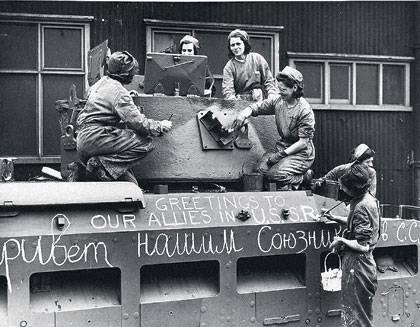
British women are preparing the tank "Matilda" for shipment to the USSR under the Lend-Lease. In the UK then everything Soviet was very fashionable and popular, so that the workers with sincere pleasure displayed Russian words on the tank's armor.
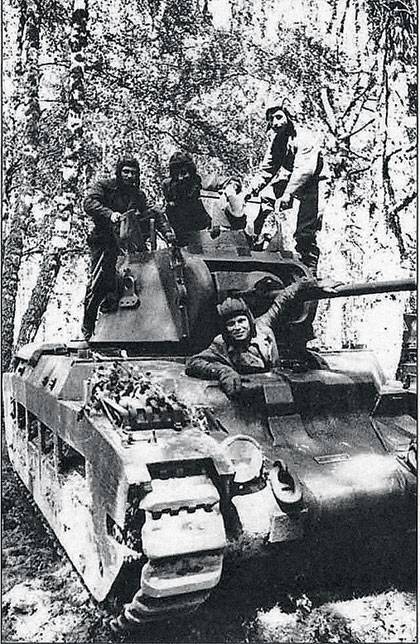
The crew of the British medium tank Mk II Matilda II, delivered to the USSR under the Lend-Lease. Bryansk Front, summer 1942 of the year.
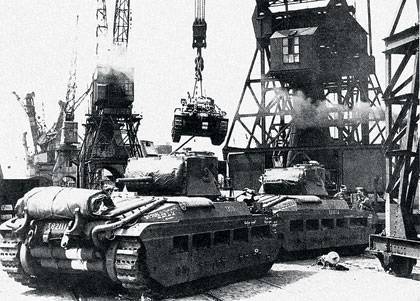
Loading tanks "Matilda" in one of the British ports to be sent to the USSR.
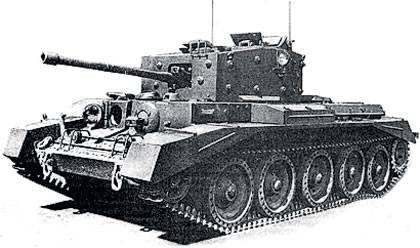
Cromwell MK VII The story of the lend-lease armored vehicles would be incomplete, if not to mention a few cars sent specifically for testing. These are five American tanks М5, two М24 "Chaffee" and one М26 "General Pershing", as well as six British "Cromwell". Add 115 armored repair and recovery vehicles M31, created on the basis of the medium tank M3, and 25 of the Valentine Bridalleader roadblocks.
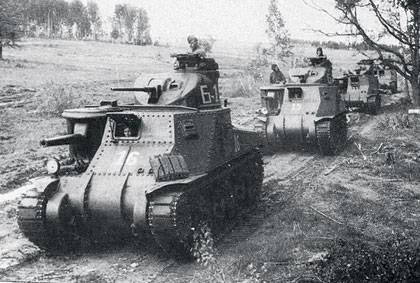
A company of General Li, the M3s of American tanks, supplied under Lend-Lease in the USSR, is being pushed to the front line of the Soviet 6 Guards Army. July 1943 of the year.
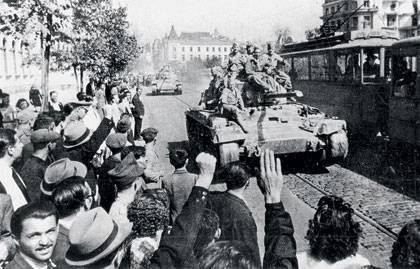
The jubilant residents of Sofia greet Soviet soldiers entering the Bulgarian capital on “Valentine” tanks, which were supplied to the USSR under Lend-Lease.
Information